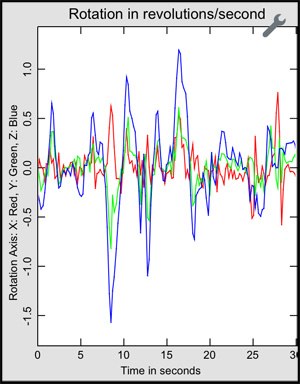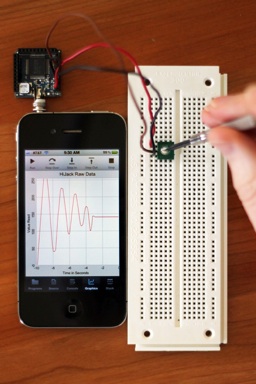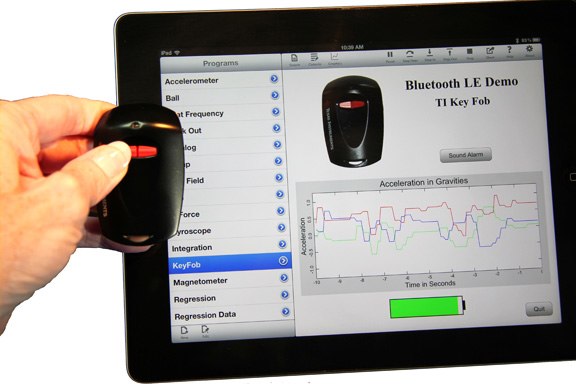techBASIC


Collect Data
-
•Collect, analyze and display data right on your iPhone/iPad
-
•Use FTP, TCP/IP or HTTP to access or archive data via WiFi connections
-
•Access any Bluetooth LE device from iPhones (4s and later) and iPads (3rd gen and later) or iPod (retina display or later)
-
•Access to the accelerometer, magnetometer and gyroscope
-
•Get the current location and heading
-
•Collect data from outside sensors using HiJack
-
•Take photos or grab images from the photo library; analyze them pixel-by-pixel
-
•Import data from your desktop computer
-
•Send data to your desktop computer
-
•Works on the iPad, iPod or iPhone




Accelerometer
All iPhones and iPads have a built in accelerometer that measures up to 2 gravities (about 18.6 meters/second^2) along three axis. It’s the perfect tool to understand dozens of ideas from physics and science.
Here we’re plotting the overall G force as a person jumps up and down. You can clearly see zero G at the tops of the jumps.
Grabbing data from the accelerometer is simple. A single call returns the current acceleration along each axis in an array.
Magnetometer
All iPads and all iPhones starting with the 3GS model have a built in magnetometer that measures magnetic fields up to 1 Tesla.
The classic use for the magnetometer is to find the direction, as in the compass app. It’s a general purpose tool, though. Here you see the magnetic field generated by a refrigerator magnet as it passes over the iPhone. For another use, see this blog, which shows how a simple techBASIC program turns your iPhone into a metal detector.
Gyroscope
Gyroscopes are built in to iOS devices starting with the iPad 2 and iPhone 4. The gyroscope measures the rotation rate along 3 axis.
The plot you see here is from a stunt kite flight. That’s right, we attached an iPhone to a stunt kite to see how fast it would rotate and what the G forces were on the kite! You can clearly see that the kite rotated up to 1.5 revolutions per second on some turns. If you look closely, you cam also see that the kite’s nose dipped down on turns in either direction (the red line). The green line shows the kite turning as the strings were pulled, leading the rotation a bit.
See this blog for a fun description of this stunt kite flight.
Heading
Getting the compass heading from magnetometer and gyroscope readings used to be a complicated process. Fortunately, techBASIC makes it easy. A single call returns both the magnetic and true heading, along with error and a time stamp.
Location
Current location is useful for all sorts of things, from geology to hiking. One call gives you the current location of your iPhone or iPad, including the latitude, longitude, altitude, and even the error.
HiJack
When a Tricorder just isn’t enough, you can add almost any sensor to your iPad or iPhone using HiJack. It plugs right into the headphone jack, letting you connect any sensor your talent and ingenuity can create. See this blog for a simple HiJack project that will get you started.



Apps for people who think.™





Bluetooth Low Energy
Access the Internet of Things right from your iPhone or iPad! Starting with the iPhone 4s and iPad 3, iOS hardware can access Bluetooth LE devices. techBASIC lets you write programs to collect data, send commands, and communicate with any Bluetooth LE peripheral.
The photo shows a short techBASIC program that responds when buttons are pressed on a key fob and grabs accelerometer data from a 3 axis accelerometer in the key fob. Press the Sound Alarm button and the key fob starts to beep and blink. See this blog to learn how to write your own Bluetooth LE programs.

BLE and iOS Sensor Support
Bluetooth low energy in Action
techBASIC enables you to collect, analyze and display sensor data right on your iPhone/iPad
techBASIC allows you to write programs to connect to any Bluetooth low energy device
Collect Data and Control the Internet of Things
